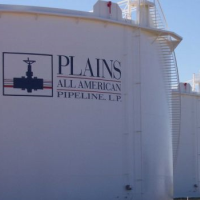Santa Barbara Oil Spill Follow-Up: Time to Clean the Decrepit Pipeline
 (photo: Plains All American Pipeline)
(photo: Plains All American Pipeline)
Crude oil has lain dormant for months in a 128-mile stretch of pipeline from the Pacific to Bakersfield whose condition resembles the 10.6-mile corroded pipeline it is connected to, which burst on May 19 and coated the Santa Barbara coast in 143,000 gallons of goo.
What could go wrong with that?
The federal Pipeline and Hazardous Materials Safety Administration (PHMSA) issued a directive last week with the answer—a whole lot of things. The agency sent an amended order without a hearing to Plains All American Pipeline (PAAP) telling it to purge Line 903 immediately because there is a “likelihood of serious harm to life, property, or the environment.”
Line 901, the one that burst, carried oil from pipelines connected to offshore drilling rigs to a pumping station near Gaviota, where it hooked up with Line 903 for transport to Kern County. Line 901 has already been purged, but Line 903 is still “full of crude.” Plains is also required to purge three other offshore lines that feed Line 903.
“It does not appear that Plains has an effective corrosion control program,” the PHMSA wrote in its order.
The unprocessed oil contains natural gas and a host of contaminants. During the purge Plains is supposed to keep a close eye on “nearby drainages, culverts, and highly-populated areas.” To that end, the order required them to purge during daylight hours.
Plains’ safety record indicates that particular condition, and others like it, needed to be a formal part of the record. After the spill, the Los Angeles Times did a quick check of the PHMSA database and found Plains had three times the number of infractions per mile of pipeline than the national average. They were fifth on a list of 1,700 pipeline operators in the total number of infractions.
Reporters counted 175 infractions in multiple states since 2006 that involved pipeline corrosion, operator error and pump failure. More than 688,000 gallons of hazardous materials were spilled during the incidents.
A section of Line 901 was excavated after the spill and its shoddy condition caught the attention of regulators. The company couldn’t find some internal safety evaluations on the line, and pressure-testing records for tanks handling surges in hazardous material were inadequate. But the level of corrosion found in the excavation greatly exceeded measurements anomalies and wear made by automated devices, called smart pigs.
Without testing and record-keeping, the company couldn’t perform maintenance. “In all the documentation I have reviewed concerning the pipeline, I have never seen evidence of any advanced risk assessment and management processes being used by Plains,” Robert Bea, a civil engineering professor at University of California, Berkeley, told the Associated Press.
Plains operates 18,900 miles of oil and natural gas pipelines nationally, in addition to 8,100 rail cars, 2,890 trucks and trailers, 149 transport and storage barges, 72 transport tugs, and 125 million barrels of storage capacity.
The Plains stock price dropped 51.4% in the past year, but the plummeting price of crude oil on world markets probably had more to do with it than the Santa Barbara spill. Plains is spending $257 million to make amends, but insurance companies are picking up $192 million of the bill, according to Motley Fool.
The spill, at Refugio State Beach, occurred on the edge of a national marine sanctuary and state-designated underwater preserve that is full of whales, dolphins and sea lions, in addition to dozens of species of sea birds and more than 500 species of fish. It is still under investigation.
–Ken Broder
To Learn More:
Federal Regulators Order Clean Out of California Pipeline (by Alison Sider, Wall Street Journal)
Regulators Tell Plains to Purge Shut California Oil Pipeline (by Kristen Hays, Reuters)
Fearing Corrosion, Regulators Order Santa Barbara Oil Pipeline Emptied (by Javier Panzar, Los Angeles Times)
Feds Wag Finger but Don’t Fine Oil Company for Santa Barbara Pipeline Spill (by Ken Broder, AllGov California)
- Top Stories
- Controversies
- Where is the Money Going?
- California and the Nation
- Appointments and Resignations
- Unusual News
- Latest News
- California Forbids U.S. Immigration Agents from Pretending to be Police
- California Lawmakers Urged to Strip “Self-Dealing” Tax Board of Its Duties
- Big Oil’s Grip on California
- Santa Cruz Police See Homeland Security Betrayal in Use of Gang Roundup as Cover for Immigration Raid
- Oil Companies Face Deadline to Stop Polluting California Groundwater





